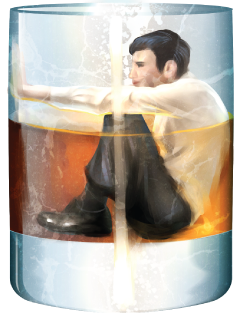
A glass of wine with dinner or a couple of beers while watching the big game may seem like a harmless way to unwind, for 14 million Americans, it is not possible to just have one or two drinks.
Alcoholism, also known as alcohol dependence syndrome, is a disease characterized by an addiction to the consumption of liquor and alcoholic beverages.
Alcohol is a central nervous system depressant. This means that it affects the body by slowing down central nervous system activity. Even in small doses, alcohol affects decision-making and reaction time.
In moderate to large doses, alcohol can lead to severe impairment, leading to risky decision making and causing physical damage to an individual’s liver and brain. Continued alcohol use and abuse increases the risk for health problems and an early death.
If you believe that a loved one is struggling with an addiction to alcohol, this information will help you better understand alcoholism and the steps you can take to help your loved one seek treatment for their dependency.
[separator top=”40″ style=”single”]
Download the Full Guide to Alcoholism Treatment[separator top=”40″ style=”single”]
Who abuses alcohol?
Over half of all adults (51.5%) aged 18 or older are regular drinkers, consuming 12 or more drinks in the last year. Alcohol abuse is highest amongst non-Hispanic whites; 27 percent of non-Hispanic whites report abusing alcohol within the last year. Nineteen percent of Hispanics and 15 percent of African-Americans report abusing alcohol within the last year. The need for alcohol treatment is highest among 18 to 25 year olds, with 17.2% needing treatment. More men than women – 10.9% versus 4.8% – need treatment.
How is binge drinking related to alcoholism?

75 percent of all alcohol consumed in the United States is in the form of binge drinking. Individuals who binge drink are at greater risk for developing alcohol dependency and alcohol-related health problems. Binge drinking is a growing problem, especially amongst adolescents and college students. 90 percent of all alcohol consumed by youths under the age of 21 is in the form of binge drinking. However, not all binge drinking is limited to youth; 70 percent of binge drinking episodes involve adults aged 26 or older.
How does alcohol abuse affect society?

Alcohol abuse costs everyone. In 2006, excessive drinking, including binge drinking, cost the United States $223.5 billion in lost productivity, increased crime and increased health care costs. Every day, nearly 30 people die in car crashes due to alcohol impairment.
One in three crash deaths involves a drunk driver, resulting in more than 10,000 deaths each year. If a loved one is struggling with alcohol addiction, they struggle affects more than just their personal health, family and friends.
By helping a loved one seek treatment for alcoholism, you not only are helping to save their life, but also potentially saving the lives of other Americans that would have been needlessly endangered.
Is alcoholism genetic?
Recent research suggests that certain individuals may be predisposed towards alcoholism and alcohol abuse.
Alcoholism often appears to run in certain families; individuals whose parents or siblings abuse alcohol are at increased risk for developing their own problems with alcohol.
According to the National Institute on Alcohol Abuse and Alcoholism, multiple genes play a role in determining whether someone develops alcohol problems. However, these genes only account for about half of the risk for alcoholism; environmental factors, along with the interaction between genes and the environment, account for the other portion of an individual’s risk.
While genetics certainly affect an individual’s risk for alcohol abuse, genes are only part of the puzzle.
[separator top=”40″ style=”single”]
Download the Full Guide to Alcoholism Treatment[separator top=”40″ style=”single”]
